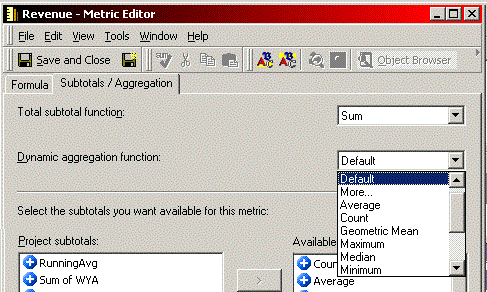MicroStrategy ONE
Changing the default dynamic aggregation function
The dynamic aggregation function is used to aggregate the data whenever the metric is dynamically aggregated, regardless of what function is used in the metric definition. You can change the default function used for dynamic aggregation in the Subtotals / Aggregation tab of the Metric Editor, as shown below.

The validity of the data depends on whether the function can correctly calculate the data within the report. For this reason, it is recommended that you evaluate your report requirements and consider the report results before you make the function selection for dynamic aggregation.
The functions that can be used as the dynamic aggregation function are:
- Average
- Count (Distinct=true)
- Geometric Mean
- Maximum
- Median
- Minimum
- Mode
- Product
- Standard Deviation
- Sum
- Variance
- User-defined function
You cannot directly use a function as the dynamic aggregation function of a metric. You must use or create a subtotal that uses the function in its definition. For information on creating a subtotal, search the online help for "Creating user-defined subtotals".
Metrics defined with certain functions use a default dynamic aggregation function that returns the correct results in most situations. For example, a metric defined with the Sum function uses the Sum function to dynamically aggregate its data. You can change the dynamic aggregation function for this type of metric, but it is recommended that you do not change these default functions as this can cause erroneous or null results for the metrics in a report. For more information on metrics with default dynamic aggregation functions, see Metrics with default dynamic aggregation functions.
Aggregating data from a report with certain functions can return erroneous or null results, and therefore the default dynamic aggregation function is set to none. You can set the default dynamic aggregation function so that these metrics return data instead of null values. For example, if a metric is defined with Standard Deviation, you can change the function used for dynamic aggregation from Default to Standard Deviation.
You can, however, use a function that does not match the function or functions used to define the metric. To see an example that uses this technique, see Estimating dynamic aggregation values with different aggregation functions.
To change the default dynamic aggregation function
- In MicroStrategy Developer, right-click a metric and select Edit. The Metric Editor opens.
- On the Subtotals / Aggregation tab, select a function from the Dynamic aggregation function drop-down list.
- Click Save and Close.
